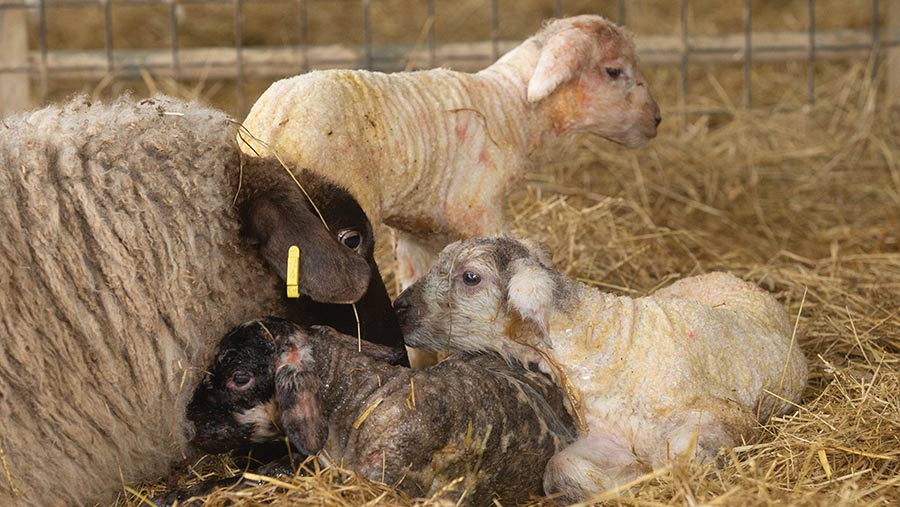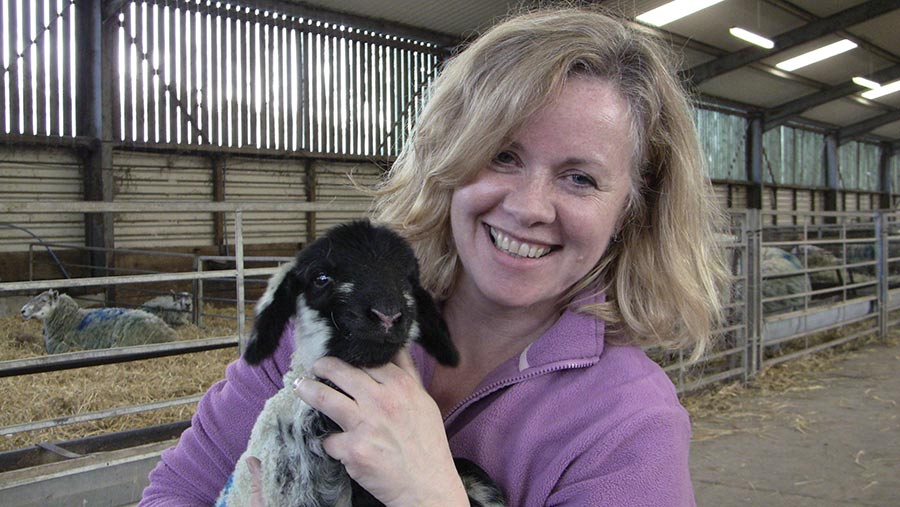Advice on planning for triplet lambs and options for rearing
 © Tim Scrivener
© Tim Scrivener Sheep farmers considering increasing the prolificacy of their flocks have the potential to increase sales by €15 (£12.80) a ewe for every 0.1 additional lamb reared successfully, according to Teagasc research officer Tim Keady.
The key is to mitigate the risk of higher mortality that comes with such an approach (see “Options for managing triplets”).
See also: Expert advice on assessing and managing lambing difficulties
“Once you know your scan rate, you know what percentage of ewes will be carrying triplets and can plan your management strategy,” he says (see “Effect of litter size on incidence of triplets”).
If greater prolificacy is the aim, more triplets will be an inevitable consequence, says Cathy Dwyer, professor of animal behaviour and welfare at Scotland’s Rural College (SRUC).
Triplet lambs are not only smaller than singles or twins, but they are also compromised biologically. This means they inevitably require more management and more input, she says.
“Even if we take out of the equation the fact that they’re smaller, they are still less active, less able to maintain body temperature and slower to suckle. There is a real difference being a triplet.
“The issue often is that two lambs will be sharing a uterine horn, so it’s not just about the mother’s ability to transfer nutrients, but about oxygen and space too,” she adds.

Cathy Dwyer © Marianne Farish SRUC
Maternal behaviour
Long-term behavioural studies of Scottish Blackface and Suffolk ewes by Cathy and her team have established that ewes do not markedly alter their behaviour if they have three lambs rather than two.
They simply divide the amount of licking, grooming and so on between three.
“On the whole, they do that quite effectively. But they can only do so much. If a ewe divides all her time between three lambs, they are always going to get a bit less care than being a single or a twin.
“The biggest impact, though, is being born as a triplet, and if there is higher mortality, it’s mostly because of biological reasons,” she says.
Different approach
Further research found a marked difference in triplet management between farmers in the UK and Ireland, and those in New Zealand (NZ).
“Of those responding to the survey, 65% of NZ farmers would keep all three lambs on the ewe, compared with 12% in the UK and 14% in Ireland. So, there’s a big split in approach,” says Cathy.
“At the start of the research, I was thinking very much from a UK perspective: that everyone wants twins, and triplets are a bit of a pain but an inevitable consequence.
“In NZ, they seem to be doing a pretty good job of rearing them on the ewe. For them it was a bit of a no-brainer – why would you not?
“[But] I tend to think it’s not quite as amazing as they make out as that extra lamb is somewhat compromised, and there is a cost to the ewe. But an extra lamb from each ewe is a bit of a game changer in terms of profitability.”
The survey, which drew responses from a total of 452 farmers (who were scanning at an average of 1.8 lambs a ewe and lambing at 1.6-1.7 lambs a ewe) also found the chances of survival of triplet lambs were best achieved by “good practice, but even better”.
“Everything you should be doing anyway if you have singles and twins, do more of it if you’ve got triplets, because these lambs are more vulnerable,” says Cathy.
This means:
- Be more prepared
- Manage nutrition better
- Have better hygiene
- Be more responsive to animal’s needs.
Effect of litter size on incidence of triplets |
|
|
Mean litter size |
Incidence of triplets (%) |
|
1.8 |
8 |
|
2 |
15 |
|
2.2 |
25 |
|
2.6 |
55 |
|
Source: Tim Keady, Teagasc |
|
Options for managing triplets
Keep triplet with the ewe
The ewe carrying triplets will require a total of 8kg concentrates in late pregnancy and 18kg (0.5kg/day) for five weeks of lactation.
Triplet lambs will need up to 300g/day until weaning – 60kg for three lambs. Total concentrate requirement: 86kg.
When testing this strategy, Tim Keady’s research showed triplets born and reared with this additional supplementation were as heavy as twins born and reared without the additional supplementation. He calculated the extra cost of supplement to rear a third lamb at €30 (£26), with a benefit to cost ratio of 3:1.
Sell as baby lambs
Surplus lambs can be sold on to units set up for rearing them artificially.
Rear surplus lambs artificially
Lambs require adequate colostrum and should be removed from the ewe 24-48 hours after birth.
They should be grouped according to age and size, supervised to ensure they are sucking, and given access to clean water and concentrate (see “Pros and cons of artificial rearing methods”).
Good standards of hygiene for pens and feeding equipment are essential.
Pros and cons of artificial rearing methods
Bottle rearing
✔ Cheapest method
✔ Feeders with teats can feed up to 10 lambs
✘ Most labour intensive
✘ Lambs prone to digestive upsets
Ad-lib feeder
✔ Low incidence of digestive upsets
✔ Holds up to 50 litres of milk and can feed up to four groups of lambs
✘ Cost €400 (£342)
✘ Requires electricity for heating element and thermostat
✘ Labour – mixing replacer and cleaning equipment
Automated feeder
✔ Low incidence of digestive upsets
✔ Lowest labour requirement
✔ Can feed up to 250 lambs
✘ Cost €4,000 (£3,419)
✘ Requires mains water, electricity, and milk replacer
Source: Tim Keady, Teagasc
